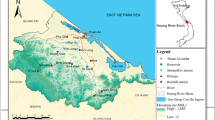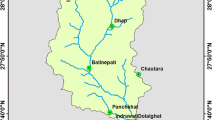Abstract
This study investigated the future climate change impacts on water resources and delineated the highly susceptible zones in the Asian monsoon region. Three General Circulation Models (GCMs) were employed for future climate change projections. The change factor method with bilinear interpolation was used to project climate change at 0.5° horizontal gird resolution. The Variable Infiltration Capacity (VIC) macroscale hydrological model was employed to project runoff using future climate change scenarios. Average temperature, precipitation and runoff were projected to increase by all future periods i.e., 2020s, 2050s and 2080s. In particular by 2080s, they were projected to increase by 3.7 °C, 10.7 and 11.1 %, respectively. Latitudinal and longitudinal analysis was performed to investigate the features of future climate change at different latitudes and longitudes. The climate change projections revealed susceptible regions in East Asia over southern China, and in South Asia over the Tibetan plateau, India and Pakistan. Southern China was projected to be adversely affected by climate change with precipitation and runoff increase during summer and autumn seasons, and decrease during winter and spring seasons. Similarly, distinct climate change features were projected over the Tibetan plateau and north Pakistan with significant increase of average annual temperature and decrease of average annual precipitation and runoff. This change is alarming for the world’s longest glaciers outside the Polar Regions. On the other hand, the precipitation and runoff were projected to significantly increase over southwest India and south Pakistan. That may have positive impact over extremely water-scarce regions i.e., the Thar Desert, the Cholistan Desert and the Kharan Desert, but also poses a serious threat to the flood prone areas of South India and Pakistan.









Similar content being viewed by others
References
Abbaspour KC, Faramarzi M, Ghasemi SS, Yang H (2009) Assessing the impact of climate change on water resources in Iran. Water Resour Res 45(10), W10434. doi:10.1029/2008WR007615
Annamalai H (2007) IPCC climate models and the Asian summer monsoon. IPRC Climate 7:10–14
Awan JA, Bae D-H, Kim K-J (2015) Identification and trend analysis of homogeneous rainfall zones over the East Asia monsoon region. Int J Climatol 35(7):1422–1433. doi:10.1002/joc.4066
Bae D-H, Georgakakos KP, Kim S (2007) Screening the utility of climate information for watershed applications in Korea. J Hydrol 336(1):38–47
Bae D, Rahman M, Koike T, Ahmad B (2013) Climate change impact assessment on the Asia-Pacific water resources under AWCI/GEOSS. Final Report of the APN ARCP Project: ARCP2011-05CMY-Bae
Change C (2007) Synthesis report. Contribution of Working Groups I, II and III to the Fourth Assessment Geneva. IPCC, Switzerland, p 104
Chenoweth J et al (2011) Impact of climate change on the water resources of the eastern Mediterranean and Middle East region: modeled 21st century changes and implications. Water Resour Res 47(6)
Fao I (1998) World reference base for soil resources. World Soil Resour Rep 84:21–22
Faramarzi M et al (2013) Modeling impacts of climate change on freshwater availability in Africa. J Hydrol 480:85–101
Gao X, Shi Y, Song R, Giorgi F, Wang Y, Zhang D (2008) Reduction of future monsoon precipitation over China: comparison between a high resolution RCM simulation and the driving GCM. Meteorol Atmos Phys 100(1–4):73–86
Georgakakos KP (2003) Probabilistic climate-model diagnostics for hydrologic and water resources impact studies. J Hydrometeorol 4(1):92–105
Georgakakos KP, Bae D-H, Jeong C-S (2005) Utility of ten-day climate model ensemble simulations for water resources applications in Korean watersheds. Water Resour Manag 19(6):849–872
Hay LE, Wilby RL, Leavesley GH (2000) A comparison of delta change and downscaled GCM scenarios for three mounfainous basins in the United States. J Am Water Resour Assoc 36(2):387–397
Jeong CS, Heo J-H, Bae DH, Georgakakos KP (2005) Utility of high-resolution climate model simulations for water resources prediction over the Korean Peninsula: a sensitivity study. Hydrol Sci J 50(1)
Jung I-W, Bae D-H, Im E-S (2007) Generation of high resolution scenarios for climate change impacts on water resources (II): Runoff scenarios on each sub-basins. J Korea Water Resour Assoc 40(3):205–214
Kreins P, Henseler M, Anter J, Herrmann F, Wendland F (2015) Quantification of climate change impact on regional agricultural irrigation and groundwater demand. Water Resour Manag 29(10):3585–3600
Le T, Bae D-H (2013) Evaluating the utility of IPCC AR4 GCMs for hydrological application in South Korea. Water Resour Manag 27(9):3227–3246
Lee M-H, Bae D-H (2015) Climate change impact assessment on green and blue water over Asian monsoon region. Water Resour Manag 29(7):2407–2427
Lee B-J, Jung I-W, Bae D-H (2009) Parameter regionalization of semi-distributed runoff model using multivariate statistical analysis. J Korea Water Resour Assoc 42(2):149–160
Li T, Luo J-J (2011) Projection of future precipitation change over China with a high-resolution global atmospheric model. Adv Atmos Sci 28(2):464–476
Liang X, Lettenmaier DP, Wood EF, Burges SJ (1994) A simple hydrologically based model of land surface water and energy fluxes for general circulation models. J Geophys Res 99(D7):14415–14428
Liang X, Wood EF, Lettenmaier DP (1996) Surface soil moisture parameterization of the VIC-2L model: evaluation and modification. Global Planet Chang 13(1):195–206
Liuzzo L, Noto LV, Arnone E, Caracciolo D, La Loggia G (2014) Modifications in water resources availability under climate changes: a case study in a sicilian basin. Water Resour Manag 29(4):1117–1135
Mourato S, Moreira M, Corte-Real J (2015) water resources impact assessment under climate change scenarios in Mediterranean Watersheds. Water Resour Manag 29(7):2377–2391
Nakaegawa T, Kitoh A, Hosaka M (2013) Discharge of major global rivers in the late 21st century climate projected with the high horizontal resolution MRI‐AGCMs. Hydrol Process 27(23):3301–3318
Reason C, Keibel A (2004) Tropical cyclone Eline and its unusual penetration and impacts over the southern African mainland. Weather Forecast 19(5):789–805
Son K-H, Lee J-D, Bae D-H (2010) The application assessment of global hydrologic analysis models on South Korea. J Korea Water Resour Assoc 43(12):1063–1074
Turner AG, Annamalai H (2012) Climate change and the South Asian summer monsoon. Nat Clim Chang 2(8):587–595
Wang B (2006) The asian monsoon. Springer, Berlin Heidelberg
Wang J et al (2012) China’s water–energy nexus: greenhouse-gas emissions from groundwater use for agriculture. Environ Res Lett 7(1):014035
White CJ, Tanton TW, Rycroft DW (2014) The impact of climate change on the water resources of the Amu Darya basin in central Asia. Water Resour Manag 28(15):5267–5281
Acknowledgments
This research was supported by a grant (14AWMP-B082564-01) from Advanced Water Management Research Program funded by Ministry of Land, Infrastructure and Transport of Korean government, and by the Korea Meteorological Administration Research and Development Program under Grant KMIPA 2015-2070.
Author information
Authors and Affiliations
Corresponding author
Rights and permissions
About this article
Cite this article
Bae, DH., Koike, T., Awan, J.A. et al. Climate Change Impact Assessment on Water Resources and Susceptible Zones Identification in the Asian Monsoon Region. Water Resour Manage 29, 5377–5393 (2015). https://doi.org/10.1007/s11269-015-1124-6
Received:
Accepted:
Published:
Issue Date:
DOI: https://doi.org/10.1007/s11269-015-1124-6




